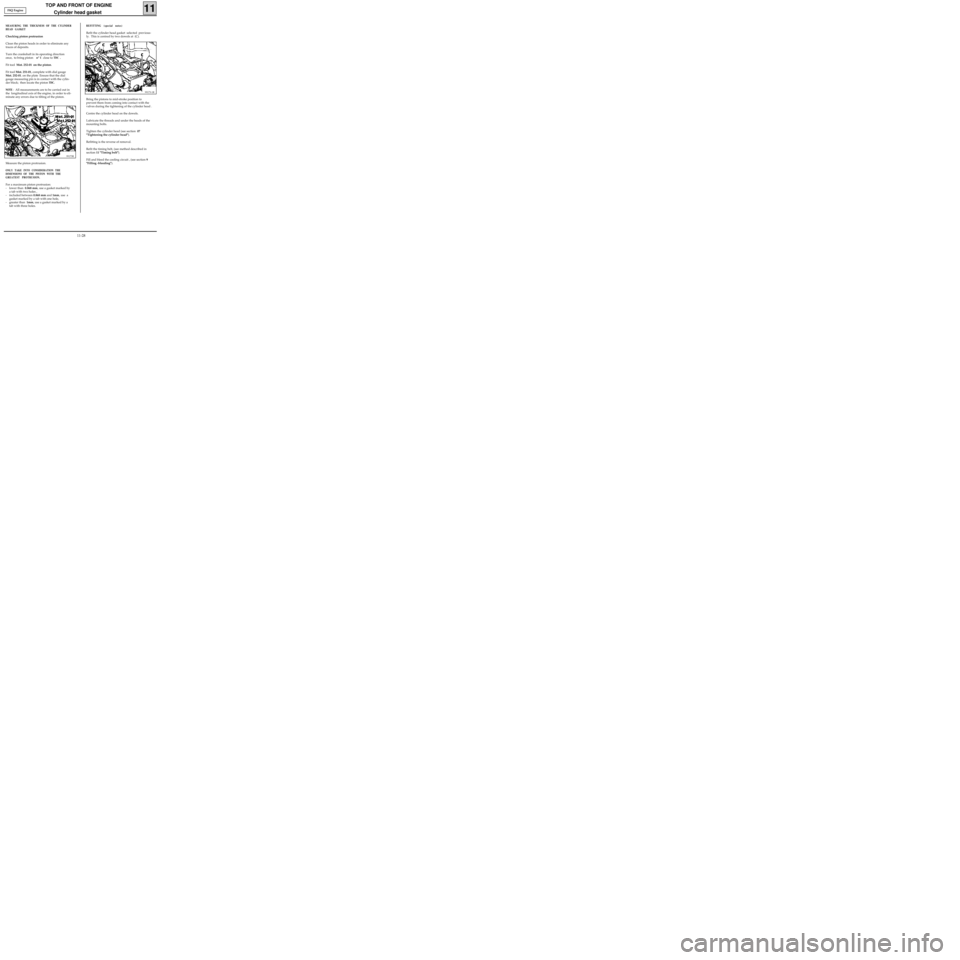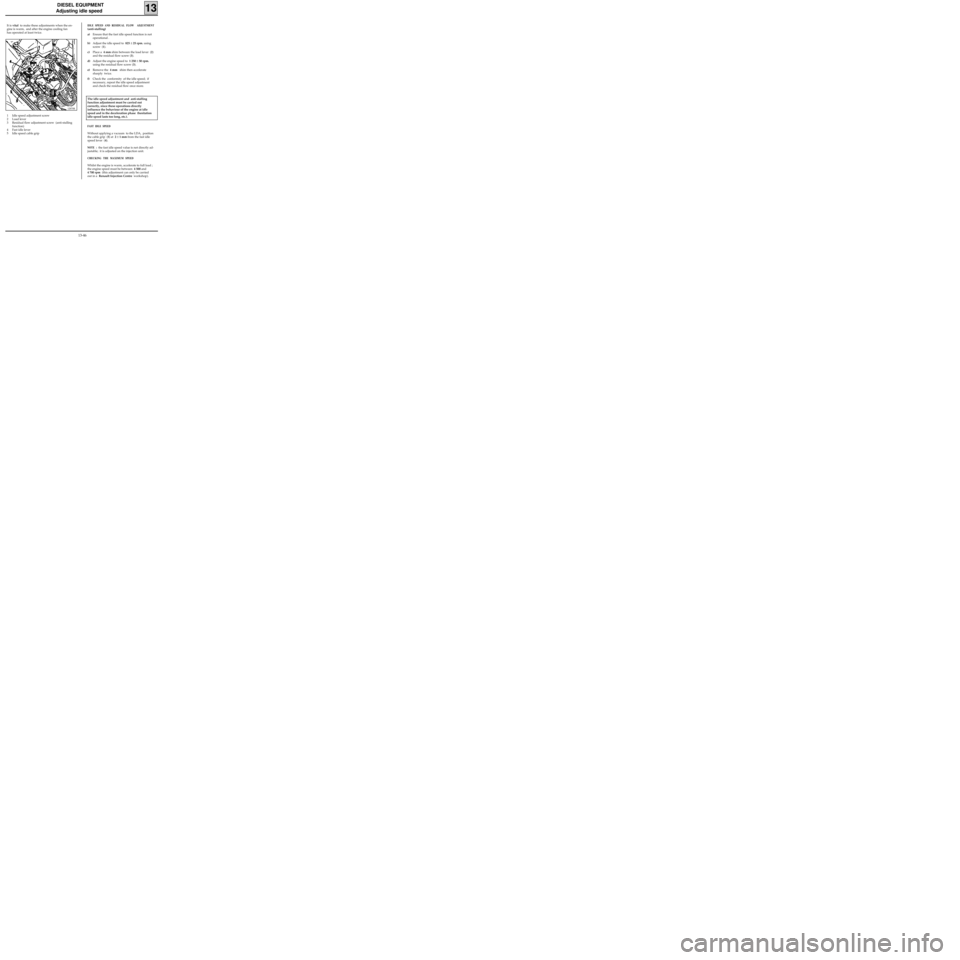Page 63 of 208

TOP AND FRONT OF ENGINE
Cylinder head gasket
11
REFITTING (special notes)
Refit the cylinder head gasket selected previous-
ly. This is centred by two dowels at (C).
99173-1R
Bring the pistons to mid-stroke position to
prevent them from coming into contact with the
valves during the tightening of the cylinder head .
Centre the cylinder head on the dowels.
Lubricate the threads and under the heads of the
mounting bolts.
Tighten the cylinder head (see section 07
"Tightening the cylinder head").
Refitting is the reverse of removal.
Refit the timing belt, (see method described in
section 11 "Timing belt").
Fill and bleed the cooling circuit , (see section 9
"Filling -bleeding").
MEASURING THE THICKNESS OF THE CYLINDER
HEAD GASKET
Checking piston protrusion
Clean the piston heads in order to eliminate any
traces of deposits.
Turn the crankshaft in its operating direction
once, to bring piston n° 1 close to
TDC .
Fit tool Mot. 252-01 on the piston.
Fit tool Mot. 251-01, complete with dial gauge
Mot. 252-01. on the plate Ensure that the dial
gauge measuring pin is in contact with the cylin-
der block; then locate the piston
TDC.
NOTE
: All measurements are to be carried out in
the longitudinal axis of the engine, in order to eli-
minate any errors due to tilting of the piston.
99173R
Measure the piston protrusion.
ONLY TAKE INTO CONSIDERATION THE
DIMENSIONS OF THE PISTON WITH THE
GREATEST PROTRUSION.
For a maximum piston protrusion:
- lower than 0.868 mm, use a gasket marked by
a tab with two holes ,
- included between 0.868 mm and 1mm, use a
gasket marked by a tab with one hole,
- greater than 1mm, use a gasket marked by a
tab with three holes. F8Q Engine
11-28
Page 92 of 208
FUEL SUPPLY
Antipercolation device
13
When the ignition is switched off, the coolant temperature monitoring mode begins.
E7J Engine
Monitoring mode
Water temperature≥ 101°C
Coolant temperature ≤ 96°C Cooling fan assembly control time
≥ 10 minutes
Cooling fan assembly stops
Exit from monitoring mode
The monitoring mode is left 2 minutes after switching off the ignition in cases where the coolant
temperature is not greater than or equal to 101°C or once the coolant temperature falls below 92°C.
no
yes
nono
yes yes
High speed cooling fan assembly command
13-12
Page 126 of 208

DIESEL EQUIPMENT
Adjusting idle speed
13
12870R
It is vital to make these adjustments when the en-
gine is warm, and after the engine cooling fan
has operated at least twice.
The idle speed adjustment and anti-stalling
function adjustment must be carried out
correctly, since these operations directly
influence the behaviour of the engine at idle
speed and in the deceleration phase (hesitation
idle speed lasts too long, etc.).
1 Idle speed adjustment screw
2 Load lever
3 Residual flow adjustment screw (anti-stalling
function)
4 Fast idle lever
5 Idle speed cable grip
FAST IDLE SPEED
Without applying a vacuum to the LDA, position
the cable grip (5) at 2 ± 1 mm from the fast idle
speed lever (4).
NOTE : the fast idle speed value is not directly ad-
justable; it is adjusted on the injection unit.
CHECKING THE MAXIMUM SPEED
Whilst the engine is warm, accelerate to full load ;
the engine speed must be between 4 500 and
4 700 rpm (this adjustment can only be carried
out in a Renault Injection Centre workshop).
IDLE SPEED AND RESIDUAL FLOW ADJUSTMENT
(anti-stalling)
a)Ensure that the fast idle speed function is not
operational .
b)Adjust the idle speed to 825 ± 25 rpm. using
screw (1).
c)Place a 4 mm shim between the load lever (2)
and the residual flow screw (3).
d)Adjust the engine speed to 1 250 ± 50 rpm.
using the residual flow screw (3).
e)Remove the 4 mm shim then accelerate
sharply twice.
f)Check the conformity of the idle speed; if
necessary, repeat the idle speed adjustment
and check the residual flow once more.
13-46
Page 163 of 208

INJECTION
Coolant temperature management
244Injection coolant temperature sensor and
coolant temperature indication on
instrument panel.
3 track sensor, of which two tracks are
allocated to the injection coolant
temperature information, and one to the
indication of the coolant temperature on
the instrument panel.
259Warning coolant temperature switch for
instrument panel.
Operating principle
Sensor 244 allows :
- the coolant temperature to be shown on the
instrument panel,
- the injection computer to receive constant in-
formation on the engine coolant temperature
.
The injection computer, depending on the co-
olant temperature, controls :
- the injection system,
- the cooling fan assembly.
The engine cooling fan assembly is controlled
at fast speed (both slow and fast speeds are
controlled by the air conditioning system) if
the temperature is greater than 99°C. If the
temperature falls below 96°C, it cuts off
automatically ( if a check has to be carried out,
ensure that the air conditioning is not opera-
tional).
17
11634R2
D7F Engine
13239R1
E7J Engine
17-13
Page 175 of 208
COOLING
Specifications
19
VOLUME AND GRADE OF ANTI-FREEZE
Engine Volume (in litres) Grade Special notes
D7F
E7J
F8Q5
6
7.5
GLACEOL RX (type D)
recommended coolant
onlyProtection down to - 20 ± 2°C ,
warm, temperate and cold countries
Protection down to - 37 ± 2°C for
extreme cold countries
THERMOSTAT
Engine type Starts opening (in °C) Fully open (in °C) Travel (in mm)
D7F - E7J - F8Q89 101 7.5
19-1
Page 176 of 208
COOLING
Filling and bleeding
19
There is no heater matrix water control valve.
Water flow is continuous in the heater matrix,
which contributes to the cooling of the engine.
FILLING
Check the tightening of the drain plug(s).
Open the two bleed screws.
Fill the circuit through the opening in the expan-
sion bottle.
Tighten the bleed screws as soon as the liquid
flows in a continuous jet.
Start the engine (2 500 rpm).
Adjust the level by overflow for a period of about
4 minutes .
Close the bottle.
BLEEDING
Allow the engine to run for about 10 minutes at
2 500 rpm, until the fan(s) operate (time necessary
for automatic degassing).
Check the liquid level is at the "Maximum" mar-
ker.
DO NOT OPEN THE BLEED SCREWS WHILST THE
ENGINE IS TURNING.
RE-TIGHTEN THE EXPANSION BOTTLE CAP WHILST
THE ENGINE IS WARM.
19-2
Page 177 of 208

COOLING
Testing
19
SPECIAL TOOLING REQUIRED
M.S.554-01 Adapter for M.S. 554-05
M.S.554-06 Adapter for M.S. 554-05
M.S.554-07 Kit for testing cooling circuit
sealing
97871R
Engine Colour of valve Valve rating (in
bars)
D7F-E7J-F8QBrown 1.2
1 - Testing the sealing of the circuit
Replace the expansion bottle valve with adapter
M.S. 554-01.
Connect this to tool M.S. 554-07.
Let the engine warm up then turn it off.
Pump to put the circuit under pressure.
Stop pumping at 0.1 bar less than the valve is
rated.
The pressure should not drop, otherwise look for
the leak.
Slowly unscrew the union of tool M.S. 554-07 to
decompress the cooling circuit, then remove tool
M.S. 554-01 and refit the expansion bottle valve
with a new seal.2 - Checking the rating of the valve.
If liquid passes through the expansion bottle
valve,the valve must be replaced.
On pump M.S. 554-07 fit tool M.S. 554-06 and fit
the assembly on the valve to be checked.
Increase the pressure which should stabilise at the
valve rating pressure with a test tolerance of
±
0.1 bar.
Valve rating :
19-3
Page 178 of 208
COOLING
Diagram
19
1 Engine
2 Radiator
3 ”Hot” bottle with permanent degassing
4 Heater matrix
5 3 mm diameter restriction
The fan assembly is controlled at high speed by
the injection computer if the coolant tempera-
ture is greater than 99°C.
If the coolant temperature is lower than 96°C, the
fan assembly stops operating.Water pump
Thermostat
Bleed screw
The expansion bottle valve is brown, and its rating
is 1.2 bar.
10070-2R
D7F Engine
19-4